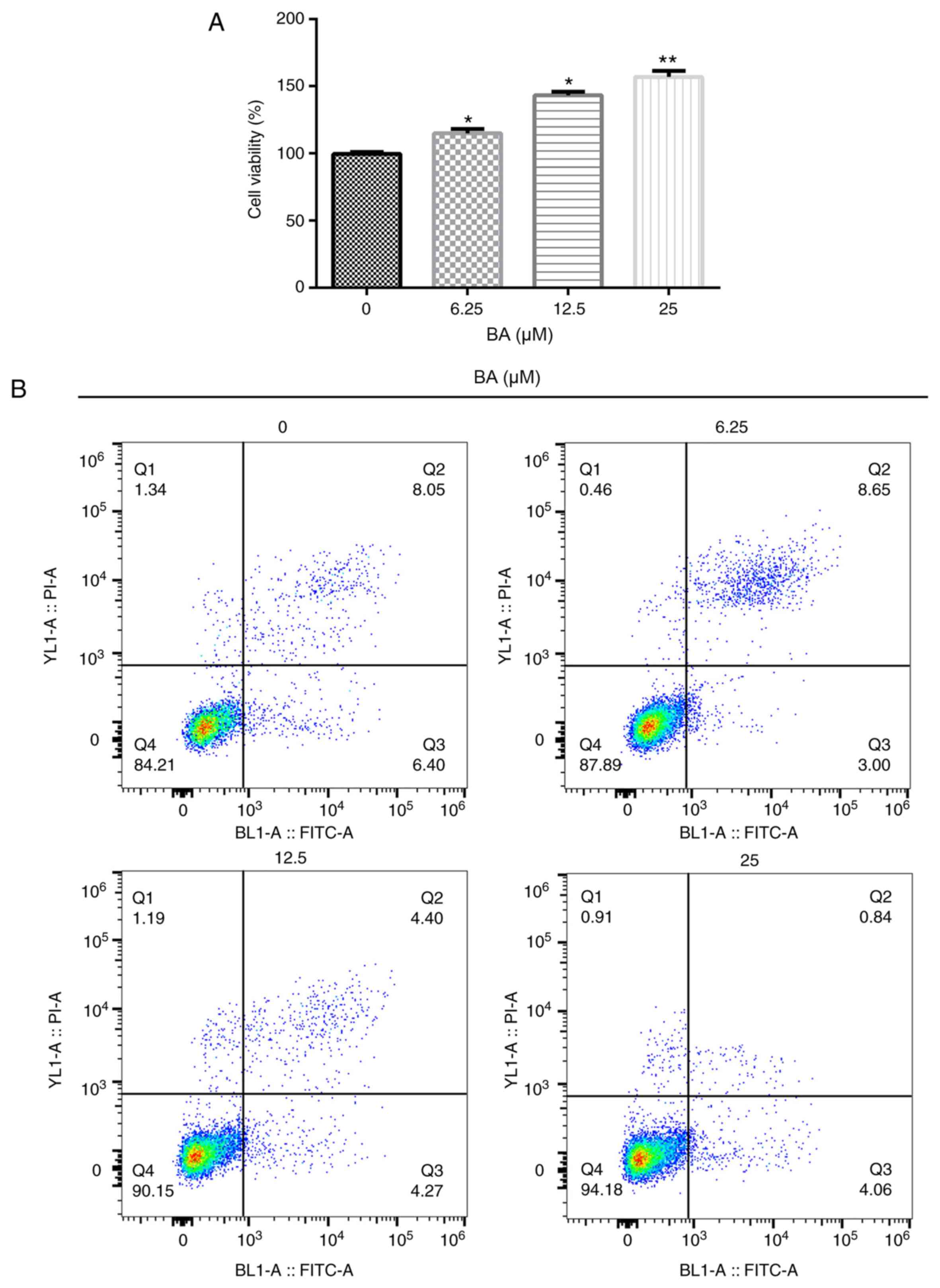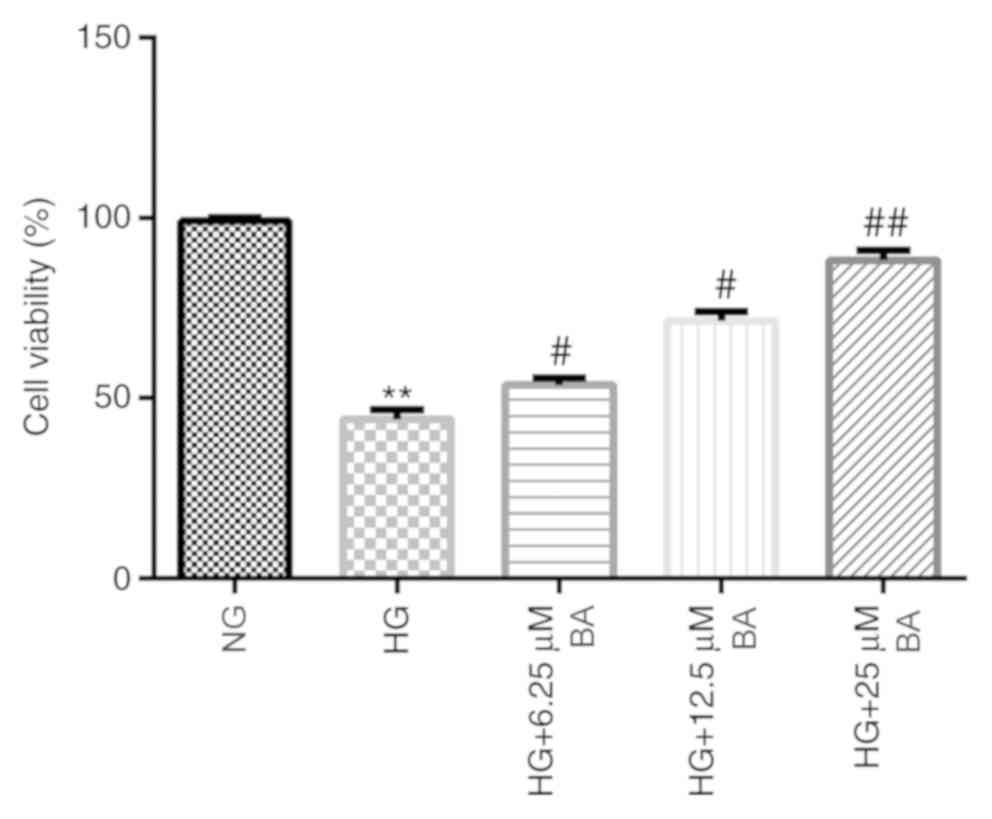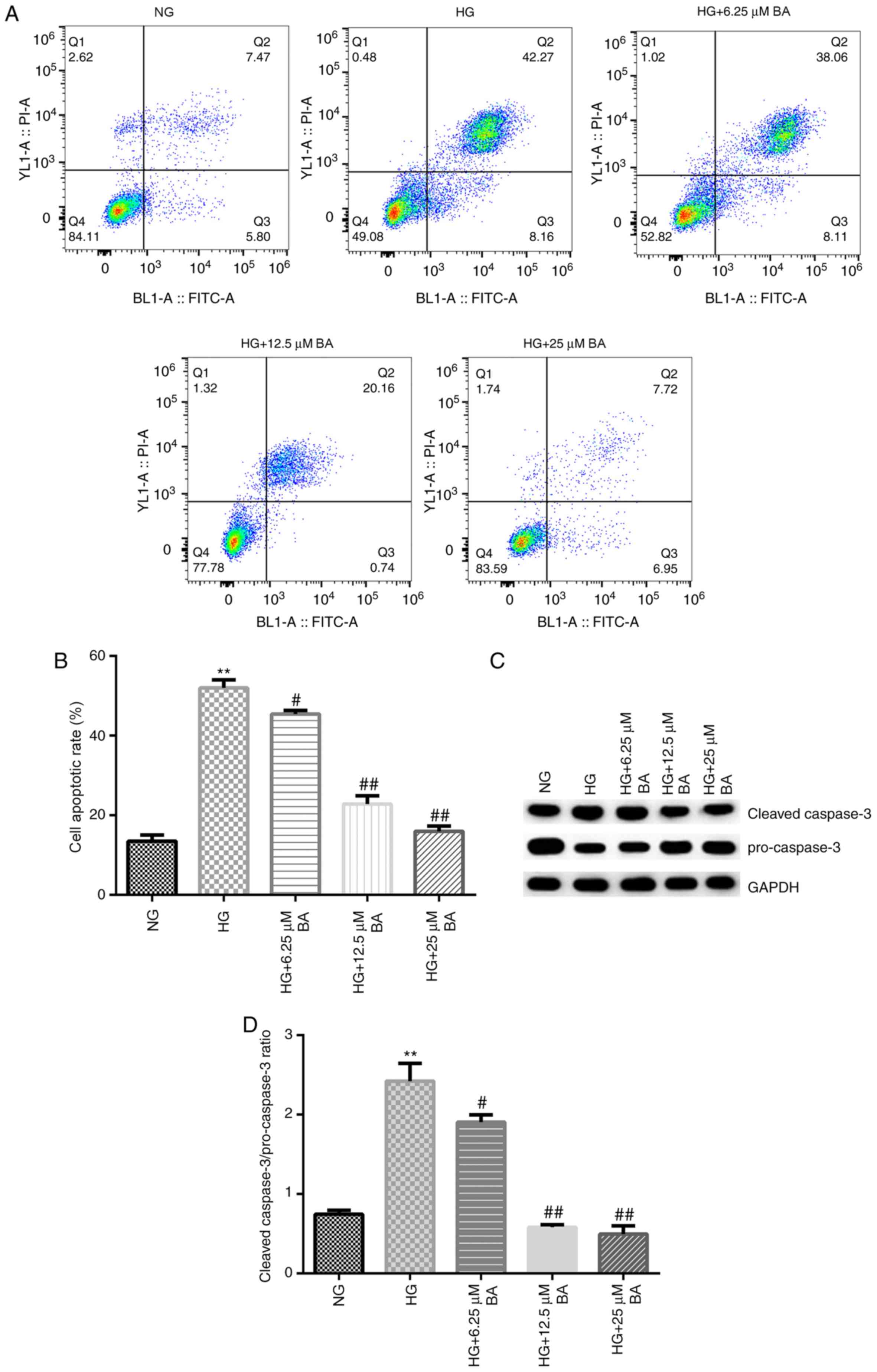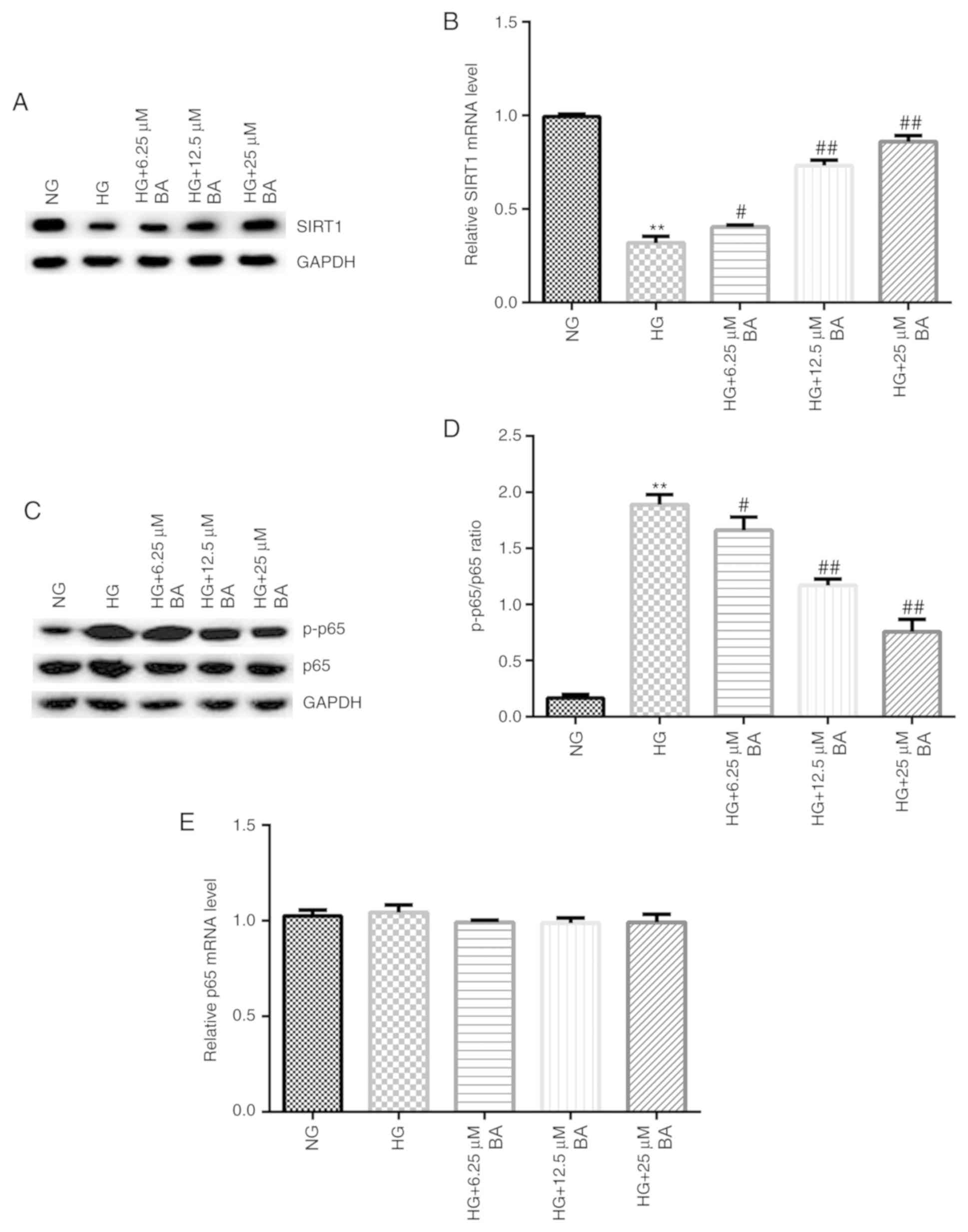|
1
|
Yang M, Kan L, Wu L, Zhu Y and Wang Q:
Effect of baicalin on renal function in patients with diabetic
nephropathy and its therapeutic mechanism. Exp Ther Med.
17:2071–2076. 2019.PubMed/NCBI View Article : Google Scholar
|
|
2
|
Akhtar M, Taha NM, Nauman A, Mujeeb IB and
Al-Nabet ADMH: Diabetic kidney disease: Past and present. Adv Anat
Pathol. 27:87–97. 2020.PubMed/NCBI View Article : Google Scholar
|
|
3
|
Fu J, Lee K, Chuang PY, Liu Z and He JC:
Glomerular endothelial cell injury and cross talk in diabetic
kidney disease. Am J Physiol Renal Physiol. 308:F287–F297.
2017.PubMed/NCBI View Article : Google Scholar
|
|
4
|
Nath KA: Tubulointerstitial changes as a
major determinant in the progression of renal damage. Am J Kidney
Dis. 20:1–17. 1992.PubMed/NCBI View Article : Google Scholar
|
|
5
|
Kowalski A, Krikorian A and Lerma EV:
Diabetic nephropathy for the primary care provider: New
understandings on early detection and treatment. Ochsner J.
14:369–379. 2014.PubMed/NCBI
|
|
6
|
Papadopoulou-Marketou N, Kanaka-Gantenbein
C, Marketos N, Chrousos GP and Papassotiriou I: Biomarkers of
diabetic nephropathy: A 2017 update. Crit Rev Clin Lab Sci.
54:326–342. 2017.PubMed/NCBI View Article : Google Scholar
|
|
7
|
Ying Q and Wu G: Molecular mechanisms
involved in podocyte EMT and concomitant diabetic kidney diseases:
An update. Ren Fail. 39:474–483. 2017.PubMed/NCBI View Article : Google Scholar
|
|
8
|
Chen J, Chen JK and Harris RC: EGF
receptor deletion in podocytes attenuates diabetic nephropathy. J
Am Soc Nephrol. 26:1115–1125. 2015.PubMed/NCBI View Article : Google Scholar
|
|
9
|
Luo J, Dong B, Wang K, Cai S, Liu T, Cheng
X, Lei D and Chen Y, Li Y, Kong J and Chen Y: Baicalin inhibits
biofilm formation, attenuates the quorum sensing-controlled
virulence and enhances Pseudomonas aeruginosa clearance in a mouse
peritoneal implant infection model. PLoS One.
12(e0176883)2017.PubMed/NCBI View Article : Google Scholar
|
|
10
|
Jia Y, Chen L, Guo S and Li Y: Baicalin
induced colon cancer cells apoptosis through miR-217/DKK1-mediated
inhibition of wnt signaling pathway. Mol Biol Rep. 46:1693–1700.
2019.PubMed/NCBI View Article : Google Scholar
|
|
11
|
Wang XF, Zhou QM, Du J, Zhang H, Lu YY and
Su SB: Baicalin suppresses migration, invasion and metastasis of
breast cancer via p38MAPK signaling pathway. Anticancer Agents Med
Chem. 13:923–931. 2013.PubMed/NCBI View Article : Google Scholar
|
|
12
|
Cao HJ, Yan YB, Dai JY, et al: Effect of
baicalin on human lung cancer A549 cell line. Chin J Exp Tradit Med
Formul. 19:216–220. 2013.(In Chinese).
|
|
13
|
Yi QQ, Xia YY, Chen J, et al: Baicalin
improves diabetic nephropathy in mice by activating Sirt1/Nrf2
signal through miR-141 inhibition. Med J Wuhan Uni. 40:186–191.
2019.(In Chinese).
|
|
14
|
Sun QR, Zhang X and Fang K: Phenotype of
vascular smooth muscle cells (VSMCs) is regulated by miR-29b by
targeting sirtuin 1. Med Sci Monit. 24:6599–6607. 2018.PubMed/NCBI View Article : Google Scholar
|
|
15
|
Morigi M, Perico L and Benigni A: Sirtuins
in renal health and disease. J Am Soc Nephrol. 29:1799–1809.
2018.PubMed/NCBI View Article : Google Scholar
|
|
16
|
Kitada M, Kume S, Takeda-Watanabe A,
Kanasaki K and Koya D: Sirtuins and renal diseases: Relationship
with aging and diabetic nephropathy. Clin Sci (Lond). 124:153–164.
2013.PubMed/NCBI View Article : Google Scholar
|
|
17
|
Shen HM and Tergaonkar V: NF-κB signaling
in carcinogenesis and as a potential molecular target for cancer
therapy. Apoptosis. 14:348–363. 2009.PubMed/NCBI View Article : Google Scholar
|
|
18
|
Deng X, Sun L, Lai X, Xiang L, Li Q, Zhang
W, Zhang L and Sun S: Tea polypeptide ameliorates diabetic
nephropathy through RAGE and NF-κB signaling pathway in type 2
diabetes mice. J Agric Food Chem. 66:11957–11967. 2018.PubMed/NCBI View Article : Google Scholar
|
|
19
|
Liu T, Zhang L, Joo D and Sun SC: NF-κB
signaling in inflammation. Signal Transduct Target Ther.
2(17023)2017.PubMed/NCBI View Article : Google Scholar
|
|
20
|
Kuhad A and Chopra K: Attenuation of
diabetic nephropathy by tocotrienol: Involvement of NF-kB signaling
pathway. Life Sci. 84:296–301. 2009.PubMed/NCBI View Article : Google Scholar
|
|
21
|
Zhu L, Han J, Yuan R, Xue L and Pang W:
Berberine ameliorates diabetic nephropathy by inhibiting TLR4/NF-κB
pathway. Biol Res. 51(9)2018.PubMed/NCBI View Article : Google Scholar
|
|
22
|
Xu L, Zhang P, Guan H, Huang Z, He X, Wan
X, Xiao H and Li Y: Vitamin D and its receptor regulate
lipopolysaccharide-induced transforming growth factor-β,
angiotensinogen expression and podocytes apoptosis through the
nuclear factor-κB pathway. J Diabetes Investig. 7:680–688.
2016.PubMed/NCBI View Article : Google Scholar
|
|
23
|
Zhang SZ, Qiu XJ, Dong SS, Zhou LN, Zhu Y,
Wang MD and Jin LW: MicroRNA-770-5p is involved in the development
of diabetic nephropathy through regulating podocyte apoptosis by
targeting TP53 regulated inhibitor of apoptosis 1. Eur Rev Med
Pharmacol Sci. 23:1248–1256. 2019.PubMed/NCBI View Article : Google Scholar
|
|
24
|
Livak KJ and Schmittgen TD: Analysis of
relative gene expression data using real-time quantitative PCR and
the 2(-Delta Delta C(T)) method. Methods. 25:402–408.
2001.PubMed/NCBI View Article : Google Scholar
|
|
25
|
Kawada T: Risk factors for developing
prediabetes. Diabetes Res Clin Pract. 135(232)2018.PubMed/NCBI View Article : Google Scholar
|
|
26
|
Peng XD, Dai LL, Huang CQ, He CM and Chen
LJ: Correlation between anti-fibrotic effect of baicalin and serum
cytokines in rat hepatic fibrosis. World J Gastroenterol.
15:4720–4725. 2009.PubMed/NCBI View Article : Google Scholar
|
|
27
|
Roy MK, Nakahara K, Na TV, Trakoontivakorn
G, Takenaka M, Isobe S and Tsushida T: Baicalein, a flavonoid
extracted from a methanolic extract of oroxylum indicum inhibits
proliferation of a cancer cell line in vitro via induction of
apoptosis. Pharmazie. 62:149–153. 2007.PubMed/NCBI
|
|
28
|
Li HY, Hu J, Zhao S, Yuan ZY, Wan HJ, Lei
F, Ding Y, Xing DM and Du LJ: Comparative study of the effect of
baicalin and its natural analogs on neurons with oxygen and glucose
deprivation involving innate immune reaction of TLR2/TNF-α. J
Biomed Biotechnol. 2012(267890)2012.PubMed/NCBI View Article : Google Scholar
|
|
29
|
Moghaddam E, Teoh BT, Sam SS, Lani R,
Hassandarvish P, Chik Z, Yueh A, Abubakar S and Zandi K: Baicalin,
a metabolite of baicalein with antiviral activity against dengue
virus. Sci Rep. 4(5452)2014.PubMed/NCBI View Article : Google Scholar
|
|
30
|
Nayak MK, Agrawal AS, Bose S, Naskar S,
Bhowmick R, Chakrabarti S, Sarkar S and Chawla-Sarkar M: Antiviral
activity of baicalin against influenza virus H1N1-pdm09 is due to
modulation of NS1-mediated cellular innate immune responses. J
Antimicrob Chemoth. 69:1298–1310. 2014.PubMed/NCBI View Article : Google Scholar
|
|
31
|
Chen J, Li Z, Chen AY, Ye X, Luo H, Rankin
GO and Chen YC: Inhibitory effect of baicalin and baicalein on
ovarian cancer cells. Int J Mol Sci. 14:6012–6025. 2013.PubMed/NCBI View Article : Google Scholar
|
|
32
|
Novy P, Urban J, Leuner O, Vadlejch J and
Kokoska L: In vitro synergistic effects of baicalin with
oxytetracycline and tetracycline against Staphylococcus aureus. J
Antimicrob Chemoth. 66:1298–1300. 2011.PubMed/NCBI View Article : Google Scholar
|
|
33
|
Lee W, Ku SK and Bae JS: Anti-Inflammatory
effects of baicalin, baicalein, and wogonin in vitro and in vivo.
Inflammation. 38:110–125. 2015.PubMed/NCBI View Article : Google Scholar
|
|
34
|
Lu L, Rao L, Jia H, Chen J, Lu X, Yang G,
Li Q, Lee KKH and Yang L: Baicalin positively regulates osteoclast
function by activating MAPK/Mitf signaling. J Cell Mol Med.
21:1361–1372. 2017.PubMed/NCBI View Article : Google Scholar
|
|
35
|
Zheng J, Asakawa T, Chen Y, Zheng Z, Chen
B, Lin M, Liu T and Hu J: Synergistic effect of baicalin and
adriamycin in resistant HL-60/ADM leukaemia cells. Cell Physiol
Biochem. 43:419–430. 2017.PubMed/NCBI View Article : Google Scholar
|
|
36
|
Ju XN, Mu WN, Liu YT, Wang MH, Kong F, Sun
C and Zhou QB: Baicalin protects against thrombin induced cell
injury in SH-SY5Y cells. Int J Clin Exp Pathol. 8:14021–14027.
2015.PubMed/NCBI
|
|
37
|
Morigi M, Perico L and Benigni A: Sirtuins
in renal health and disease. J Am Soc Nephrol. 29:1799–1809.
2018.PubMed/NCBI View Article : Google Scholar
|
|
38
|
Chang HC and Guarente L: SIRT1 and other
sirtuins in metabolism. Trends Endocrinol Metab. 25:138–145.
2014.PubMed/NCBI View Article : Google Scholar
|
|
39
|
Dai H, Sinclair DA, Ellis JL and Steegborn
C: Sirtuin activators and inhibitors: Promises, achievements, and
challenges. Pharmacol Ther. 188:140–154. 2018.PubMed/NCBI View Article : Google Scholar
|
|
40
|
Bible E: Diabetic nephropathy: Sirt1
attenuates diabetic albuminuria. Nat Rev Nephrol.
9(696)2013.PubMed/NCBI View Article : Google Scholar
|
|
41
|
Sakao Y, Kato A, Tsuji T, Yasuda H, Togawa
A, Fujigaki Y, Kahyo T, Setou M and Hishida A: Cisplatin induces
Sirt1 in association with histone deacetylation and increased
Werner syndrome protein in the kidney. Clin Exp Nephrol.
15:363–372. 2011.PubMed/NCBI View Article : Google Scholar
|


















